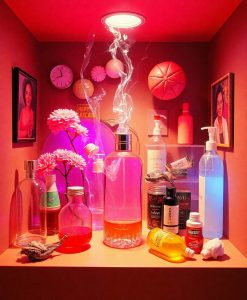Walking into a room, there’s the familiar scent of your favorite perfume or the comforting touch of body lotion. You might think these personal care products are just part of your daily routine, but they could be doing more than just making you smell good—they might be quietly influencing the chemistry of the air around you. This subtle interaction between your skin, the products you choose, and the air you breathe could be shaping your indoor environment in ways you never considered.
Understanding the invisible dance of molecules in our indoor spaces can feel overwhelming, but paying close attention to how personal care items affect air quality reveals a fascinating layer of human-environment interaction. It turns out that the chemicals in lotions and perfumes aren’t just sitting on your skin—they’re actively participating in a chemical process that influences the air chemistry of the room. This process involves the production of reactive molecules called hydroxyl (OH) radicals—tiny but powerful agents that help cleanse the air by breaking down pollutants and transforming chemicals in your surroundings.
### How Personal Care Products Suppress the Chemistry That Cleans Our Indoor Air
Recent research has shown that within indoor spaces, our presence and the chemicals we emit—whether through breathing, skin, or personal products—generate a unique oxidation field. This field involves OH radicals, which act like the air’s natural cleaning crew, neutralizing airborne toxins and maintaining a healthier environment. But here’s the surprising part: common personal care products, such as body lotions and perfumes, can substantially suppress the production of these vital radicals.
Think about the molecules in your favorite scent or moisturizer. Many contain chemicals that interfere with the formation of hydroxyl radicals—those tiny molecules that keep indoor air fresh and safe. When these products are applied, they create a chemical shield that reduces the natural oxidizing activity in your immediate environment. Essentially, your personal care routine could be dimming the very air-cleansing process that keeps your indoor air healthy.
### Why This Matters for Indoor Air Quality and Human Health
While it might seem like a small change—just a splash of lotion or a spritz of perfume—the broad impact on indoor air chemistry can be significant. The suppression of hydroxyl radicals means that certain pollutants and chemical residues linger longer in the air, potentially affecting respiratory health or exacerbating allergies. For individuals who spend much of their time indoors—whether at work, home, or social gatherings—this chemical interaction could influence overall well-being without any noticeable scent or sensation.
Moreover, the chemicals in personal care products are transformed through this oxidation field. This transformation can produce new compounds, some of which might be less healthy or more reactive than the original ingredients. The way we choose and use these products might be subtly shifting the chemical landscape of our indoor environments, influencing everything from air freshness to long-term health outcomes.
### Making Sense of Our Invisible Environment
This research invites us to consider how our daily habits—like applying lotion or perfume—are part of a complex, invisible web of chemical exchanges that shape the air we breathe. It’s a reminder that our personal choices extend beyond aesthetics and self-care into the realm of environmental stewardship, even in the smallest of ways.
For those who are conscious of indoor air quality, especially in spaces with vulnerable populations or limited ventilation, understanding the role of personal care products becomes even more important. Choosing products with fewer interfering chemicals or opting for natural alternatives might help maintain the natural oxidative processes that keep indoor air clean and healthy.

### A Call for Mindful Use of Personal Care Products
As we navigate the balance between self-expression and health, considering how our routines affect our environment can lead to more mindful choices. It’s not about giving up your favorite scents or lotions but about understanding their impact and making informed decisions that support both personal well-being and air quality.
The findings from this ongoing research highlight a subtle yet powerful connection between our daily self-care and the chemistry of the spaces we inhabit. Recognizing this link encourages us to step into our routines with awareness—embracing products that support, rather than suppress, the natural processes that keep our indoor air fresh and healthy.
Learn More: How Your Body Lotion and Perfume Could Be Quietly Changing Your Indoor Air Quality
Abstract: In 2022 a team discovered that high levels of OH radicals can be generated indoors, simply due to the presence of people and ozone. This means: People generate their own oxidation field and change the indoor air chemistry around them within their own personal space. Now, in a follow-up study again in cooperation with an international research team, they found that commonly applied personal care products substantially suppress a human’s production of OH radicals. These findings have implications for the indoor chemistry, the air quality of occupied spaces, and human health, since many of the chemicals in our immediate vicinity are transformed by this field.
Link: Read Full Article (External Site)



